

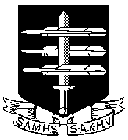 The South African
The South African
The museum started in 1982 in two classrooms of an old school building in Dundee. When we moved to our current site on the slopes of Talana Hill in March 1983, our archives fitted into two apple boxes. Today they fill four rooms, and we are about to alter and establish a fifth room.
WHAT IS OUR COLLECTION POLICY?
We collect just about anything that has some historical connection with Dundee and its surrounding area - coal mining, glass manufacture, battle of Talana and the military history of the region, local history, agriculture. When a new museum starts up and affiliates to the Provincial Museum Service they issue the museum with guidelines for their fields of collection of areas of interest. Our themes allocated were local history, coal, glass, agriculture and military history of the region - this encompasses Zulu, Voortrekker, Anglo Zulu War, First Anglo Boer War, Anglo Boer War 1899-1902 and Bambatha Rebellion.
Not many museums expand and encompass as much as we have done. We work closely with the tour guides and historians and local people in the area, which keeps information rolling in.
The museum now has 42 buildings on this historic site, with exhibits in 24 different buildings. Sixteen buildings that form the cultural village have been converted to school and group touring accommodation. I believe that the most significant collection undertaken has been that of creating the archives - documents, photos, unpublished diaries, the Dundee Courier from its 2nd edition in July 1901 till today; the minute books and documents relating to many of the coal mines that operated in the area and all the Town Council minute books for both Dundee and Glencoe, which comprises 350 odd volumes, covering Dundee from 1894-2000 and Glencoe from 1934 until incorporation with Dundee in 1994.
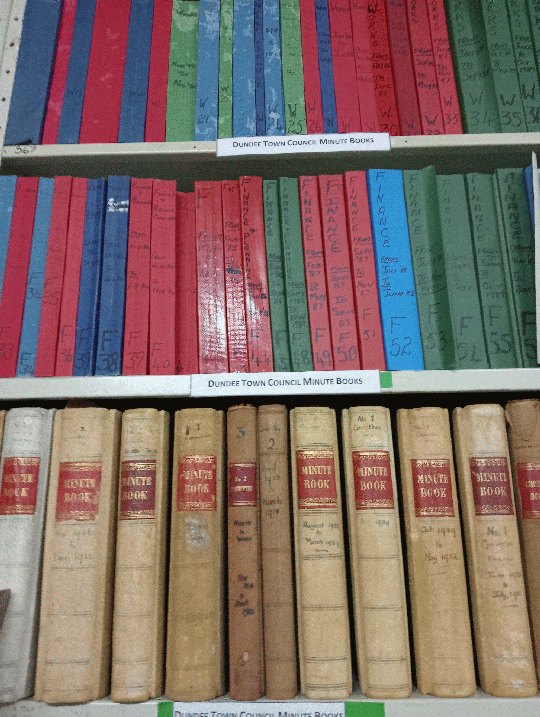
Dundee Town Council Minute Books.
Photographs inside the Journal are black and white
while coloured ones are restricted to the cover pages.
If available, colour photographs are placed on
the website, even if not used in the inside.
How have we collected all these museum items and archival and research documents? It has been a process including:
This has led to Talana Museum becoming the national coal mining museum for South Africa and the national archive depot for all coal mining documents relating to the coal industry of KwaZulu Natal and beyond our provincial borders, as there is no other place of deposit for the care of coal mining material.
126 mines have operated in Kwa-Zulu Natal and the museum holds the information and records of 92 of them.
Much of this was made possible by the tremendous amount of research done by Prof Ruth Edgecombe into the Natal coal industry. Ruth was one of my lecturers at the University of Natal and later at UNISA, and she decided after inspecting our "infant" archives, that I had learnt my lessons well and that her research would be safe here and so after her death, we inherited tons of paper.
WHY DO THESE COLLECTIONS ALWAYS COME IN THE SIZE OF TONS?
Not only was Ruth one of my lecturers but so were Paul Thompson and John Laband. When they realised I was in Dundee - originally as the history teacher at Dundee High School and serving on the museum committee - they roped me in to do much of field research for their Field Guide to the War in Zululand 1879. I spent many weekends walking sites, measuring and photographing buildings and remains for the second edition of the book. And in the process, I got to meet so many local people - all with stories to tell.
Sheila Henderson the museum committee chairperson, at the time, who had known me since the day I was born - quite literally, as she was in the room next to my mother in Sister Sandles' nursing home in Ladysmith, and had given birth to a daughter 2 days before I was born - had convinced me to join the museum committee and do field research. I may add it didn't take much convincing. I spent many years following Sheila and other historians around the battlefields, historic sites and the towns of Northern Natal and in the process collected considerable photos, family histories and other memorabilia.
Since a child I had been interested in history and had followed the historians of the region around the battlefields. My father had encouraged my interest by taking the family on Sunday outings to many of the battlefield sites.
I was asked a while ago when I had first visited Isandlwana and after giving it some thought realised it would have been almost 57 years ago.
The System
Creating an archival system requires:
Our archival systems works on the KISS system - keep it simple.
We have colour coding for the various sectors:
PINK - Biographical (Dundee and district families),
GREEN - Dundee,
BLUE - Agriculture,
ORANGE - AngloBoer War,
SILVER - Anglo Zulu War,
RED - Military (Bambatha Rebellion 1906,
WW1 and WW2 and any other conflicts),
YELLOW - Coal,
WHITE - general information - which includes all the
various areas, towns, mission stations
Whether it be a file, folder, book, document box, video, CD, photograph, map - the colour band denotes its category.
Every photograph has been scanned and originals covered in polyester - a unique product with only one manufacturer in SA - and then filed in x-ray envelopes and marked and colour coded. We very seldom use our originals as we can view them on computer screens - well over 30 000 of them.
Documents are continually being digitised but this is a long-term project - especially our collection of the Dundee Courier newspapers. Every document is numbered, according to its category, and this number is on the colour coded tag.
I always feel overwhelmed when these large collections first arrive at the museum as we unload my personal little blue Ford Bantam bakkie that has done so much sterling work to build and develop this museum. Then the sorting and creating of a system begins.
Unless we can retrieve the information what good will it serve?
AND AS I ALWAYS EXPLAIN IF WE DONíT START, THEN THERE IS NO HOPE OF EVER FINISHING.
The late Ken Gillings always told me that his research, and all the research he inherited from 'SB' Borquin and Darryl Hall, would go to Killie Campbell. After his death and at his widow Heather's request, I discussed this with them, but they refused to accept any of the documents.
And then one day into my office at the museum came
I was told that they had all decided that the only person whom they believed would be able to save Ken's collection was myself, and that I would need to collect all the files and documents and incorporate it into our archives - over 50 years of research and collecting and taking of photographs!!. And thus was born the Memorial Archives.
I arranged with Heather to collect all his documents, arriving - in my innocence - with my blue bakkie to load the items, BUT I was not prepared for the quantity. And on the kitchen floor were boxes and boxes of Darryl Halls' research and photograph collection on every artillery piece in South Africa, as well as boxes and boxes of SB's research and photos.
By the time we had fitted all the files, boxes as well as photo and slide containers, into the bakkie, on the passenger seat and floor and behind the seats there was no space left - not even for a cockroach!
Heather then still brought a whole lot more when she brought Ken's book collection for sale. I had given her five contacts for their sale, but none of them showed any interest in selling the books. Or any understanding of the value of the collection.
And so, this started not only the memorial archives but also the selling of book collections.
I had served with Ken on the Provincial Anglo Boer War centenary committee for 9 years. It was only after his death and when I started sorting and classifying his information, that I really appreciated just how much he did for the centenary and the effort that went into planning, research, marketing and that he personally attended every function. It was a phenomenal commitment.
Everything gets unpacked into the research centre - which had been a conference room, that we closed some years ago, to create space for archives and room to sort and work through documents.
Everything is always fumigated before we start and then the tremendous task of sorting, classifying into categories and giving every document and photo its own unique number and adding this to a specially created data base - and then to scan and digitise every photo before it was put away.
It took me over 20 months to do all of Ken's documents and photos - in between all the other commitments in managing the museum - and to create this incredible memorial archive.
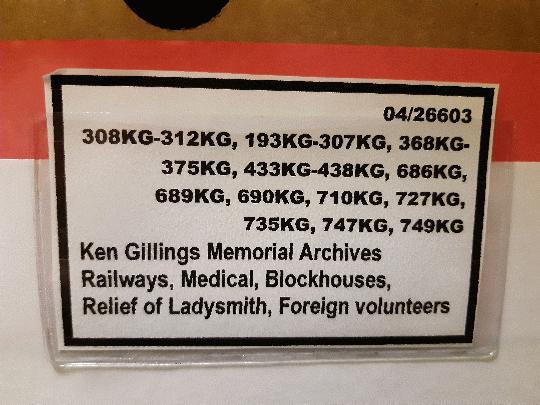
Archive indexing label
Luckily, one of our Trustees offered to convert the slides to photographs and undertook that task of over 500 slides. He later also assisted with scanning over 1500 of Steve Watt's photos - I did the rest.
This, however, is not the end of the process . all the information about each document/photo has to be captured into the data bases - this involved a total of 4494 entries for the Ken Gillings Memorial Archive.
Prof. Paul Thompson died shortly after Ken. He had assumed that his research and book collection would be accepted by the university but was very disappointed when they refused. We inherited his collection of historical and other maps of Natal, on which he had marked sites and made copious notes.
And then came Steve Watt's research. I had discussed with him for some time what he anticipated doing with his research and he said either Killie Campbell or the university. Once again another disappointment and I made the offer of Talana Museum being willing to accept his research. He hadn't given me a final answer before his death, but his children read the email messages and requested that I collect all his research material. After a disappointing reaction from book dealers, they also asked us to sell his book collection.
Again, in my ignorance, off I tootled to Howick to load the boxes and files of documents, maps and photos. And this time they did not all fit into my bakkie! Our Vice Chairman of the Board of Trustees, Des Armstrong, who lives in Howick, had come to assist, and so we packed the rear seat of his car to capacity and then the roof rack. These he brought up to Dundee a few weeks later.
Once again the piles and piles were unloaded into the research centre and the tables groaned and so did I.
The mountain of stuff was overwhelming. I did a basic sort by province and then cemeteries, grave registers, battle accounts and stacked items in archival boxes. These are special boxes rated to protect documents for 200 years and do not come cheap
BUT IF A JOB IS WORTH DOING IT IS WORTH DOING PROPERLY - and each box can hold between 300-400 sheets of paper.
Then came Covid-19 and the total closure of the museum.
Well, nothing daunted, I loaded the first lot of 87 boxes into my trusty bakkie and took them home. My spare bedroom became the archive and my grandfather's old folding card table my workspace. I have now created a very functional and useful office and it is the most used part of my house - besides my bedroom.
Nothing to distract me seven days a week and 8-10 hours a day. And five weeks later all the documents went back to the museum, sorted, classified and each document with its own unique number - and then the next lot came home and off I went again. By the end of the five months, I had done all the documents - over 3 500 - and my first guestimate of the photos of about 5 000. That turned out to be 6 426 photographs. Then I started to scan and ID and digitally file this mountain of photos. All the details had to be entered on the data bases. The photographs are now completed but we are still capturing all the documents into the data base - at the moment over 2 500 of them and still going.
Most of this data capturing was originally done by a number of volunteers - most over 70 years of age - but with Covid some have emigrated, some have died, and others just not come back and I'm not sure if they ever will.
This has slowed down the completion of the whole process.
Once again having worked with Steve on and off over the years, since he first came looking for me in 1980, for help about graves in the Dundee area, my admiration for his dedication to his subject is enormous. Over an entire life time he personally visited and recorded every military grave in South Africa - his interest spread from the Anglo Boer War to include Anglo Zulu War, Frontier Wars, Bambatha Rebellion, and the sites of submarine and shipwrecks off the coast of Natal from the World Wars.
There was one thing for which I was extremely grateful in dealing with these collections - SB was extremely thorough in identifying all his photos and their source, as was Steve. Ken, SB, Darryl, Steve, Paul Thompson, John Hawksbury were all disciplined in filing their information and photos - it was only Ken who did not identify all his photos, and trying to identify many of them, took considerable effort and time.
We have also completed sorting John Hawkesbury's collection from Rietfontein farm outside Ladysmith. Some of you may have known him. When he passed away in February 2020, he left his farm and research collection about the Boer hospital, headquarters and railway station to his next-door neighbour, George Hayes. George didn't know where to start or what to do and Des Armstrong offered my services. We have sorted, classified and filed that collection, returned it to George and have kept a printed and digital copy for our archives. His idea is to create a private museum on the farm and when he is ready to proceed, I have agreed to assist with the planning and design of the museum, display panels and items.
An earlier collection that we inherited a number of years ago was Gilbert Torlage's Anglo Boer War collection. Gilbert had served on our museum Board of Trustees for almost 20 years.
However, I would like to highlight some of the fascinating items that I came across in these and other collections that we have accepted over the past 20 years.
Among Ken and SB's documents are the permission forms that gave Ken, SB and Midge Carter special permission to enter black areas for events, and they stipulate the date and hours of entry - a very different view of the apartheid years.
SB had all his documentation for having to undergo a traditional Zulu cleansing ceremony, before being allowed to visit the sites of the burial of the Zulu kings.
I would love to be able to ask Steve how he managed to get so many of the original documents in his collection such as The Loyal League of Women's original drawings of the military cemeteries of the Anglo- Boer War, the lists of all the graves, copies of correspondence and very early photos of the cemeteries.
The most emotional collection are letters written to the Loyal League of Women from family members wanting to know where their husband, brother or son had been buried and if they could possibly have a photo and would the ladies plant a rose or other plant on the grave. There are 25 of these letters with the response noted of the replies. The first time I picked these up I couldn't read through them, as they were heartbreaking. So, I put them aside, but the whole time I knew I would have to read them eventually. A second attempt was no better and eventually they were the only documents left and I could put it off no longer. I felt foolish sitting at my desk in my home reading and crying as I read these letters. The immediacy of the tone and the pitiful requests for some information, were just so incredibly sad. Especially the one letter that a neighbour had written, as the person concerned was illiterate.
The other collection comprises records
of the War Graves Board of South Africa -
I personally think they came from Maurice
Gough-Palmer and George Chadwick -
both of whom served on the Natal branch
of the organisation. The letters and minutes
of meetings make fascinating reading. In
amongst this I found an answer to a
question I had been asking for 35 - odd
years.
- All I knew was what I had been told
sometime in the 1960's. Well, in all this
correspondence there was the answer.
A decision had been made by that
organisation that remote, individual and
graves that had no easy access would be
exhumed and relocated to more
accessible sites, where they could be
maintained. There were the lists of
graves moved, the exhumation orders
and reports and in some cases photos of
exhuming graves and relocating the
remains.
Some years ago I had a phone call
from a person in town, that I knew
reasonably well after her elderly mother
had died. She explained that when her
mother had moved in 25 years earlier
trunks and trunks of stuff had been put
into storage, had never been opened and
now they were sorting through all this
and would I come to tea and have a look.
The elderly mother turned out to be
Theophilus Shepstone's granddaughter.
In the trunks was a wealth of items -
three of which had been looted during
the Indian Mutiny - and all of her father's
papers. He was Frank Shepstone, Attorney
General of Natal, and they included
the most incredible and amazing collection
of letters written by people in England
to King Cetshwayo, on the occasion
of his visit to Queen Victoria in 1882 to
request the return of his Kingdom.
Another collection that I have just
finished sorting and classifying are the
Steenkamp papers.
Dr Louis Steenkamp was a school
teacher and schools inspector who from
1936 onwards was on the committee and
then chairman for the centenary trek into
Natal in 1938. Some of the highlights of
this collection are:
I do not know how many documents we
have in the archives - one day in my
dotage, when I have nothing better to do, I
might be able to work out how many
hundreds of thousands there are. Our
collection of mining maps is substantial -
we hold over 2 000 maps just on Durnacol
mine alone. And then there are the photos,
documents, record books, personal memories
etc.
We hold 26 unpublished diaries of the
ABW - we have published the Bailey diary
(the local Anglican minister who refused to
be sent to Pretoria as a POW, as he said it
was his responsibility to remain in Dundee
and succour the wounded) and plan to
publish others.
We have started on a concerted effort
to digitise the entire archive collection -
three museum staff and Board of Trustee
contractors have been trained and work on
this full time. Other volunteers are reading
and indexing the Dundee Couriers - over
100 years of the weekly newspaper.
Six months ago I requested that all
documents that had been completed, in
the past three months, be copied to me for
digital filing. I was pleased with the progress
but rather overcome with 114 000
documents to file. I request that they be
sent every two weeks so that I do not feel
totally threatened with the quantities, but
that does not always happen.
Since then, I have also filed a
further 22 000 photos and documents.
Recently I did a full back up
onto external hard drives of the
digitised documents and photographs
to date - that took 14 hours
and was just over 500 000 files.
The research library has now
grown from half a dozen books, to
floor to ceiling shelving all around
offices and archival rooms - thousands
of books - some extremely
rare and valuable. The focus of the
book collection has been the local
Dundee history, Anglo Zulu War,
Anglo Boer War and coal mining.
All of these archives are recorded in
data bases which are available on our
web site. Researchers can request copies
of documents and we willingly send back
scanned copies.
OH HOW TOPSY HAS GROWN!!
For more information contact https://
www.talana.co.za/index.php/services/
archives
About the Author
Pam McFadden got involved with the
local museum committee as a history
teacher in Dundee KZN, which led to her
appointment as curator of the Talana
Museum. She spent 39 years developing
the museum, collecting stories and
researching the local history.
A specialist battlefields guide for over
40 years she is passionate about the
heritage of the Battlefields route -
a tourist marketing route which she helped set up
in 1989.
Inside front Cover photograph:
Back Cover photograph:
Return to Journal Index OR Society's
Home page
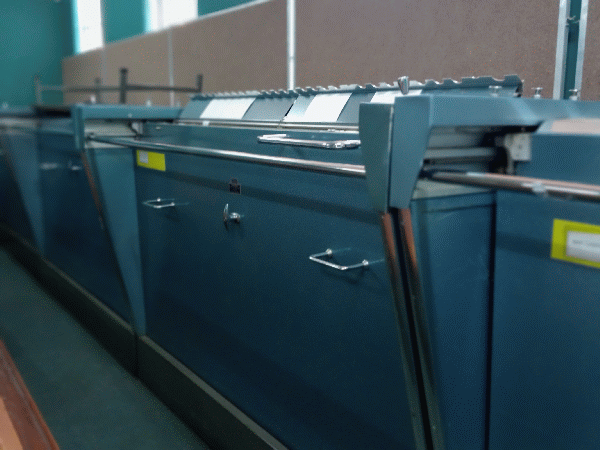
Metal cabinets that can hold
thousands of maps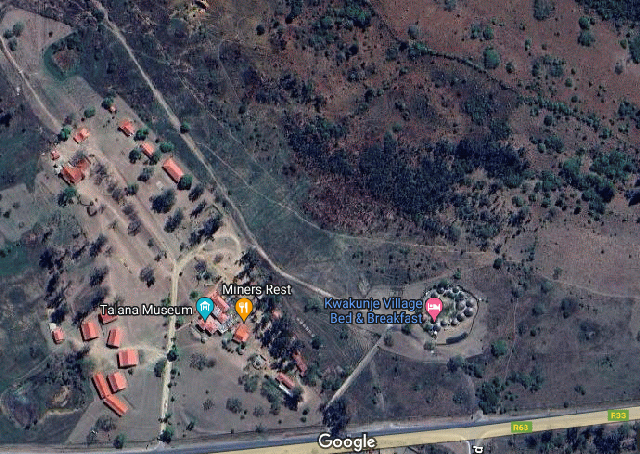
125 years ago this was a battlefield - Now Talana Museum!
The hill to the northeast of the town of Dundee in KwaZulu-Natal was the
site of an early battle in the Anglo-Boer War.
A museum on the site has expanded to become a valuable historical
resource for the region and the country.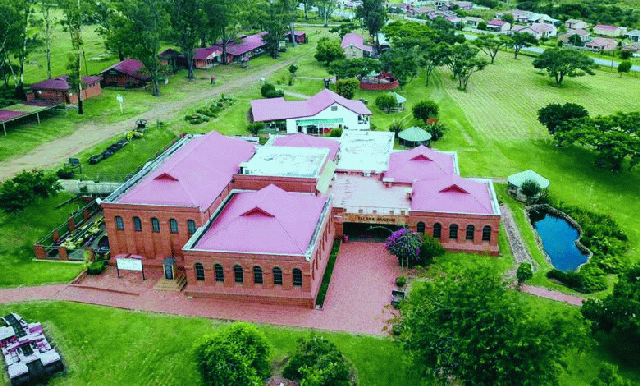
An aerial view of the Talana Museum in Dundee, KZN.
Since moving to the site in 1986 the Museum has
expanded to the point where it now has exhibits in 24
buildings. The onsite cultural village enables school
children to visit for an educational trip while the newly
opened Archives includes treasure troves of records
from SB Bourquin, Ken Gillings, Darrell Hall and Steve
Watt amongst others.